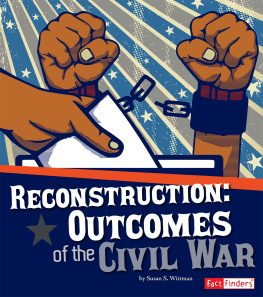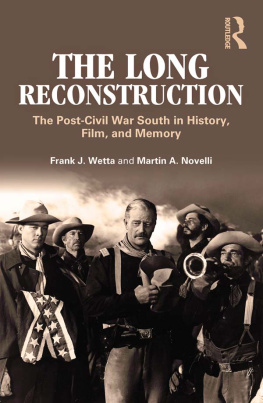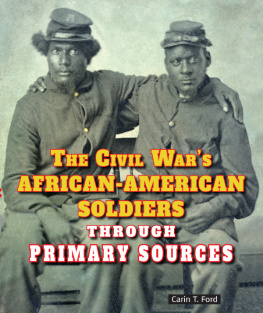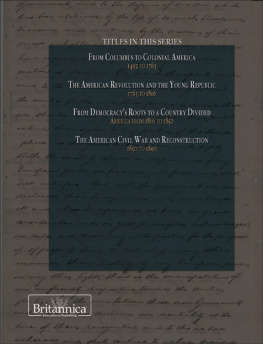A troubled time for the United States
The period following the Civil War, known as Reconstruction, was a troubled time for the United States. The North had won the Civil War and reunited the Union. The South, which had fought for its independence, was bitter as it tried to adjust to being part of the United States once again. African-American slaves were freed and made citizens. To these former slaves, the victory of the North fulfilled their dreams of being free. They found out, however, that freedom could be quickly taken away as white Southerners protested the changes it imposed upon them by the North with violence and hatred.
In The Reconstruction of the South After the Civil War in United States History, author Marsha Ziff traces the course of Reconstruction, highlighting the people and the events involved in one of the most turbulent times in American history. She examines the frustration and determination of African Americans as they began their journey out of the ruins of slavery and the Civil War toward freedom and equality.
"vignettes help bring the story of this time to life."
School Library Journal
"gripping scenes featuring key players"
The Horn Book Guide
ABOUT THE AUTHOR
Marsha Ziff grew up in the South with an interest in history, especially of the Civil War. She enjoys reading and writing both fiction and nonfiction, especially for young people.

Twenty-five-year-old Robert Fitzgerald was shocked by the destruction that surrounded him as he traveled south to Virginia in 1866. A teacher and former Union soldier, Fitzgerald had left behind his peaceful Pennsylvania home. On his journey he saw that the Southern landscape still bore the charred remains of houses and barns, although the Civil War had ended over a year earlier. Fitzgerald saw children, whose fathers had died in the war, pulling heavy plows alongside their widowed mothers. Gangs of hungry orphans scrounged through mounds of rotting garbage. No crops grew, and no farm animals grazed on the hillsides. Even the people appeared charred and ruined. Glassy-eyed, they moved like zombies. Everyone looked old and sad.
To his dismay, Fitzgerald witnessed farmers raking through fields where battles had been fought, turning up the skeletons of men and horses to use for fertilizer. Those soldiers who had survived the war resembled living skeletons. Many had lost arms or legs. Their ragged uniforms of the Confederate, or Southern, Army were held together with string because buttons with the insignia of the Confederate States of America were now forbidden.
What brought Robert Fitzgerald to this wasteland of the South? He wanted to help. He knew that, besides rebuilding homes and replanting fields, there was other important work to be done. An African-American man himself, he had heard about the millions of freed slaves who longed desperately for an education. Previously oppressed by slavery, these freedmen now gazed at an unbounded future, but they lacked learning. As slaves, they had been denied schooling. One former slave woman recalled: If they [slaveholders] caught us with a piece of paper in our pockets, theyd whip us. They was afraid wed learn to read and write, but I never got the chance.
Slowly, with the end of the war and slavery, the door to opportunity had begun to open, and Robert Fitzgerald was eager to help guide the former slaves through it. A serious scholar, he attended Lincoln University, a school for African-American men in Pennsylvania. When he heard General Oliver O. Howard, chief of the newly created Freedmens Bureau, speak at the Lincoln University graduation exercises, he had been moved by the generals emotion. Howard had urged the students to have a share in the advancement of their race, and Fitzgerald had resolved to head south for the summer to do just that.
How well would Robert Fitzgerald and others like him succeed? The period of Reconstruction, which would last from 1865 to 1877, was a time of violence, confusion, and hope. An old order had died. What would take its place?

Image credit: Enslow Publishers, Inc.
The Civil War divided the states between loyalty to the Union and the new Confederacy of the south.
In a wooded area of Virginia in April 1865, Confederate General Robert E. Lee and his starving army were surrounded and outnumbered by Union troops. The Civil War that had begun with the firing of cannons on Fort Sumter in South Carolina was nearing its end. Lee knew he was defeated. Heartbroken, he sent a white flagactually a white towelwith a note to Union General Ulysses S. Grant. On April 9, the two generals met at the house of Wilmer McLean in the town of Appomattox Court House, Virginia, to sign the articles of surrender. Then the two enemies shook hands, and Lee mounted his faithful horse, Traveller, and rode back to his conquered troops. General Grant later remembered feeling depressed at the downfall of a foe who had fought so long and valiantly and had suffered so much for a cause, though that cause was, I believe, one of the worst for which people ever fought.
Although Grant echoed the sentiments of most Northerners, Southerners had felt differently. They fought fiercely for what they called the glorious causeindependence from the United States. In December 1860, South Carolina had seceded (withdrawn) from the United States. In February 1861, representatives from South Carolina and six other states proudly formed a new nation: the Confederate States of America. Over the next few months, other Southern states joined them. They chose Montgomery, Alabama, as their first capital and Jefferson Davis of Mississippi as their president. On May 21, the capital moved to Richmond, Virginia, only one hundred miles from the United States capital at Washington, D.C. The eleven states that ultimately made up the Confederacy were South Carolina, Mississippi, Florida, Alabama, Georgia, Louisiana, Texas, Virginia, Arkansas, Tennessee, and North Carolina.
One of the issues that urged the Southern states to secede was slavery. Slaveholders in the South viewed owning slaves as a way of life. They also thought slaves were necessary to the Southern economy, which was based on cash crops grown on large plantations worked by slave labor. Abolitionists in the North believed slavery should be abolished, or done away with, and that all slaves should be emancipated, or set free. Though many Northerners were racially prejudiced and wanted only to end the influence of the slave states over the rest of the country, most in the North did believe slavery should end, somehow. Southerners came to fear that not only their economy but their entire way of life was in danger.
In the slaveholding South, the slave owner had power over the slave to buy, sell, punish, and even to kill. Slaves were considered property. In most states they could not legally marry, own land, or even be taught to read and write.
However, it was to the slaveholders advantage to provide for his slaves. Ample food, clothing, medical care, and material necessities were furnished so that the slaves would remain healthy. If they were well cared for, slaves could do more work and produce children who would grow to be strong, healthy slaves. A former slave remembered one Louisiana planter who liked to boast of the size and value of his young slaves. He said the planter often declared that raising slaves twas just like raisin young mules.











